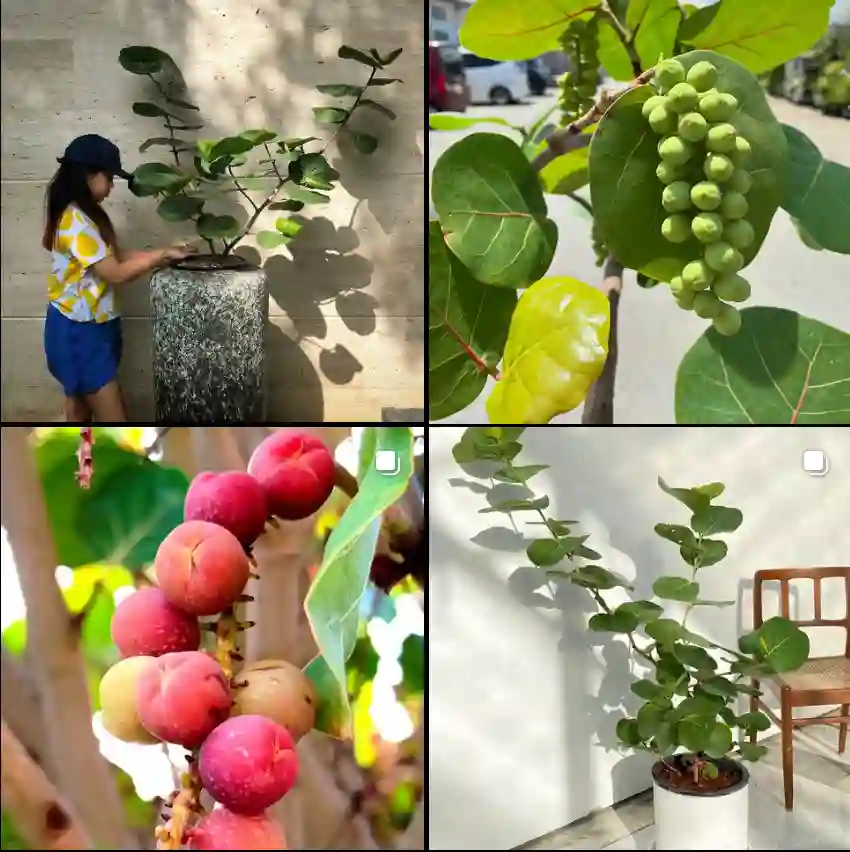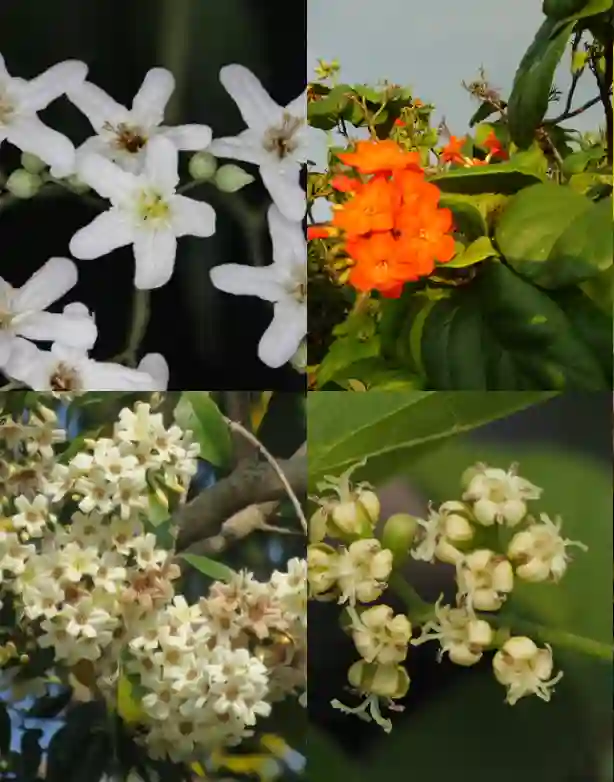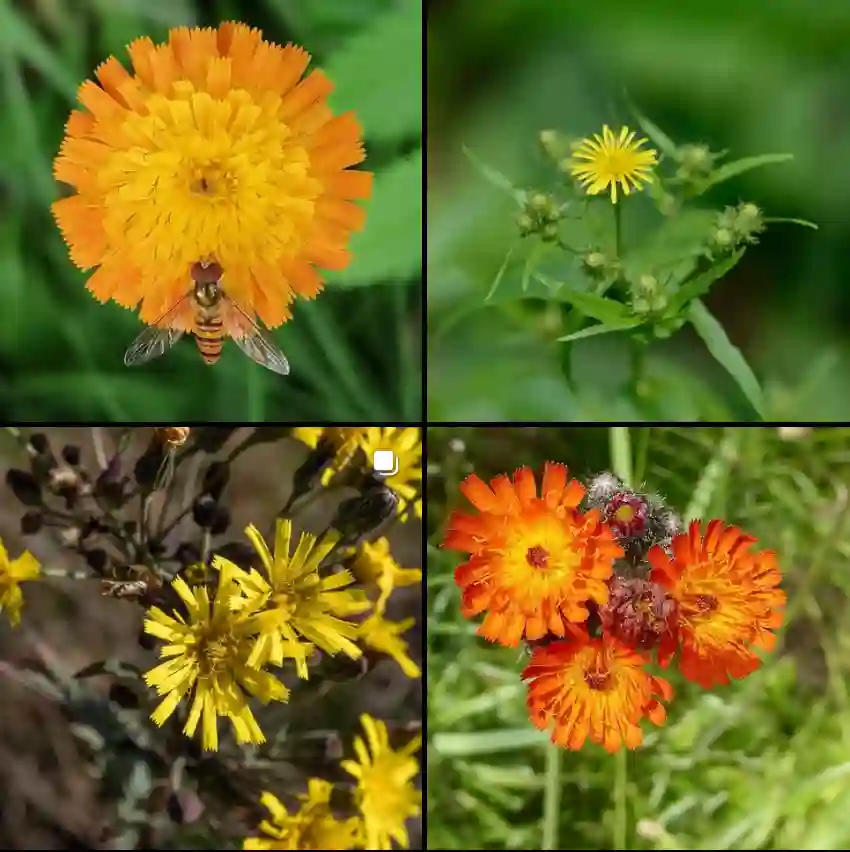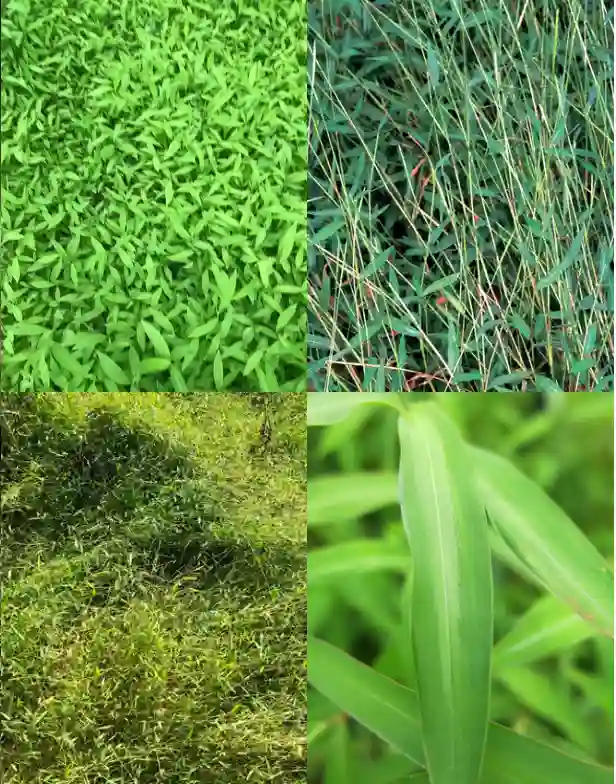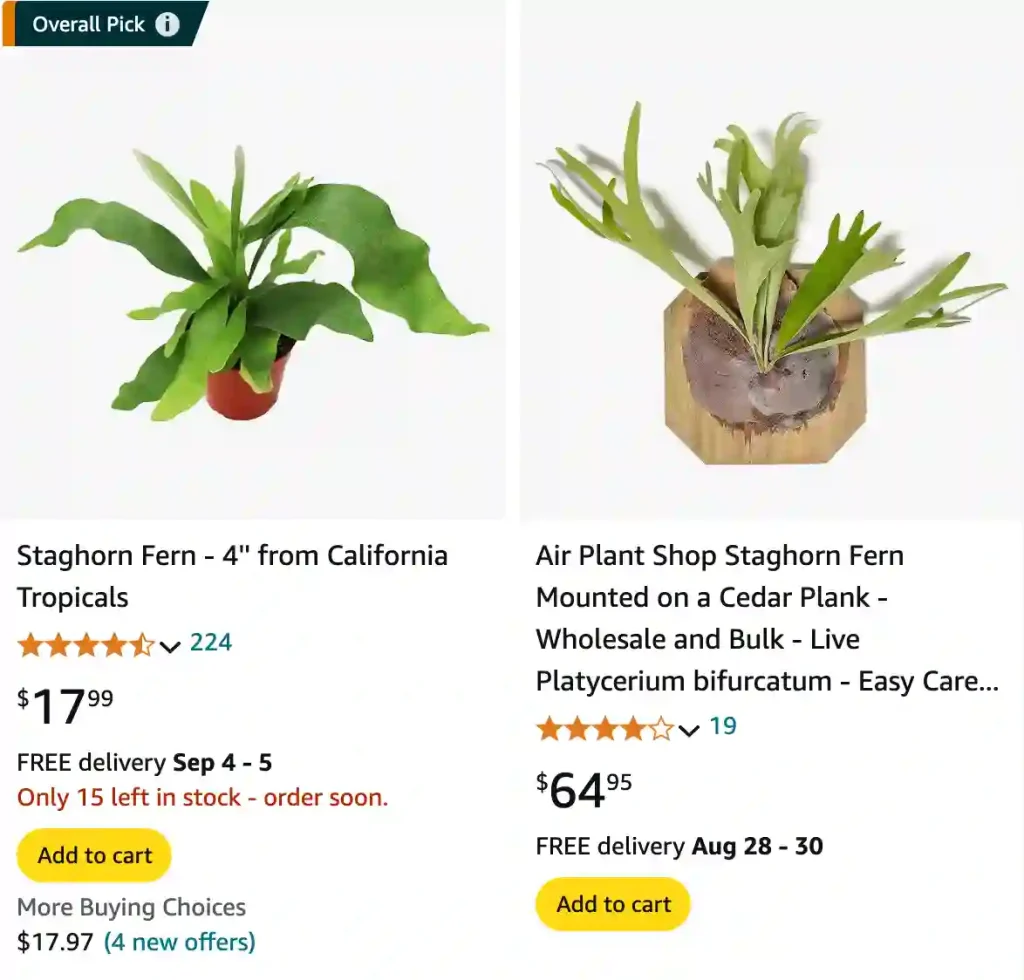
Platycerium belong to the Polypodiaceae family, also known as staghorn fern, is a genus of about 18 species of epiphytic ferns that are native to tropical and subtropical regions of Africa, Southeast Asia, Australia, and South America. They are named for their unique fronds, which resemble the antlers of a stag or deer.
Staghorn ferns are popular among plant enthusiasts because of their unique appearance and relative ease of care. They can be grown indoors or outdoors, but they typically require bright, indirect light and high humidity to thrive. They are also epiphytes, meaning they grow on trees or other plants rather than in soil, so they require a well-draining substrate like sphagnum moss or orchid bark.
18 Native Species
1. Platycerium grande – Bikakushidagrande (Giant staghorn fern)
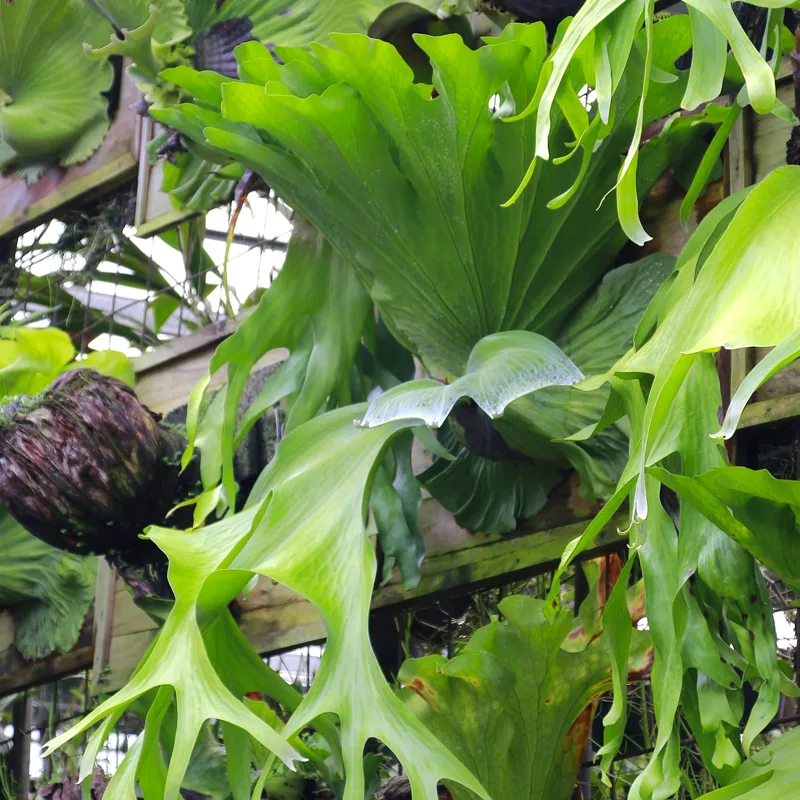
Platycerium grande, commonly known as the “Giant Staghorn Fern,” is a species of epiphytic fern native to tropical regions of Southeast Asia, including Indonesia, Malaysia, and the Philippines. As an epiphyte, it grows attached to trees and other plants, using them for support but not as a source of nutrients. This fern is known for its distinctive appearance, with large, flat, antler-like fronds that can grow up to three meters long and a meter wide. The fronds are typically green in color, but they may turn brownish-red as they age.
2. Platycerium superbum (Giant staghorn fern)
Platycerium superbum, commonly known as the “Staghorn Fern” or “Elkhorn Fern,” is a species of epiphytic fern native to Australia and Papua New Guinea. Like other staghorn ferns, it grows attached to trees and other plants, using them for support but not as a source of nutrients. This fern is known for its unique and attractive appearance, with two types of fronds: basal fronds that grow flat against the tree or support structure, and fertile fronds that grow upward and resemble antlers. The basal fronds are often a bluish-grey color, while the fertile fronds are green.
3. Platycerium wandae (Queen staghorn fern)

Platycerium wandae, commonly known as the “Wanda’s Staghorn Fern,” is a species of epiphytic fern native to the Philippines. Like other staghorn ferns, it grows attached to trees and other plants, using them for support but not as a source of nutrients. This fern is known for its unique and attractive appearance, with two types of fronds: sterile fronds that are flat and grow against the tree or support structure, and fertile fronds that grow upward and resemble antlers. The sterile fronds are often a silver-grey color, while the fertile fronds are green.
4. Platycerium wallichii (Butterfly staghorn fern)
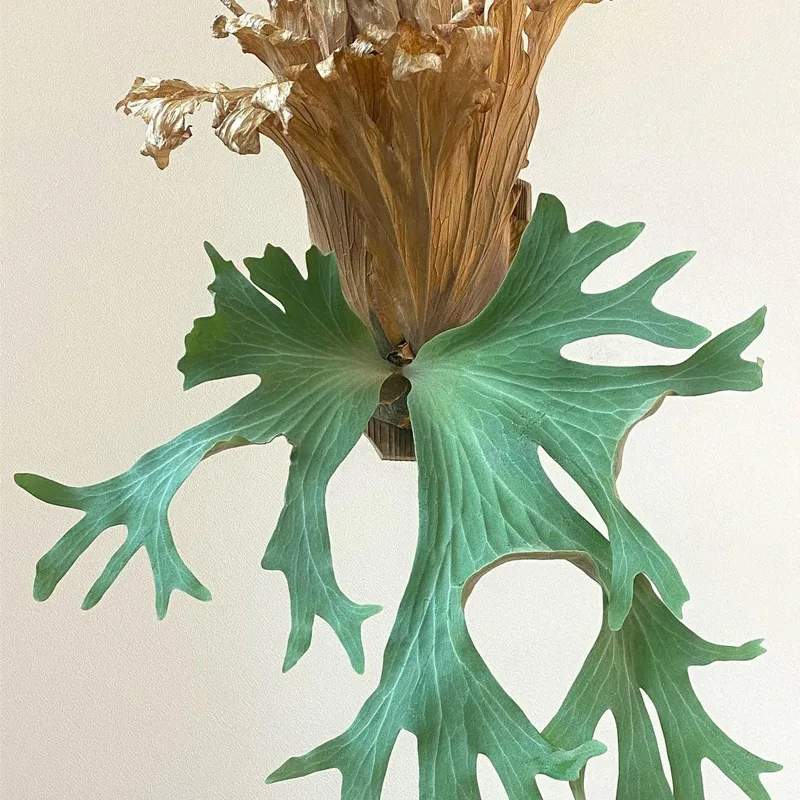
Platycerium wallichii, also known as the “Butterfly Staghorn Fern,” is a species of epiphytic fern native to Southeast Asia, including India, Nepal, Bhutan, and Myanmar. Like other staghorn ferns, it grows attached to trees and other plants, using them for support but not as a source of nutrients. This fern is known for its striking appearance, with two types of fronds: basal fronds that grow flat against the tree or support structure, and fertile fronds that grow upward and resemble butterfly wings. The basal fronds are typically a greenish-grey color, while the fertile fronds are green and somewhat translucent.
5. Platycerium holttumii (He Qimei staghorn fern)
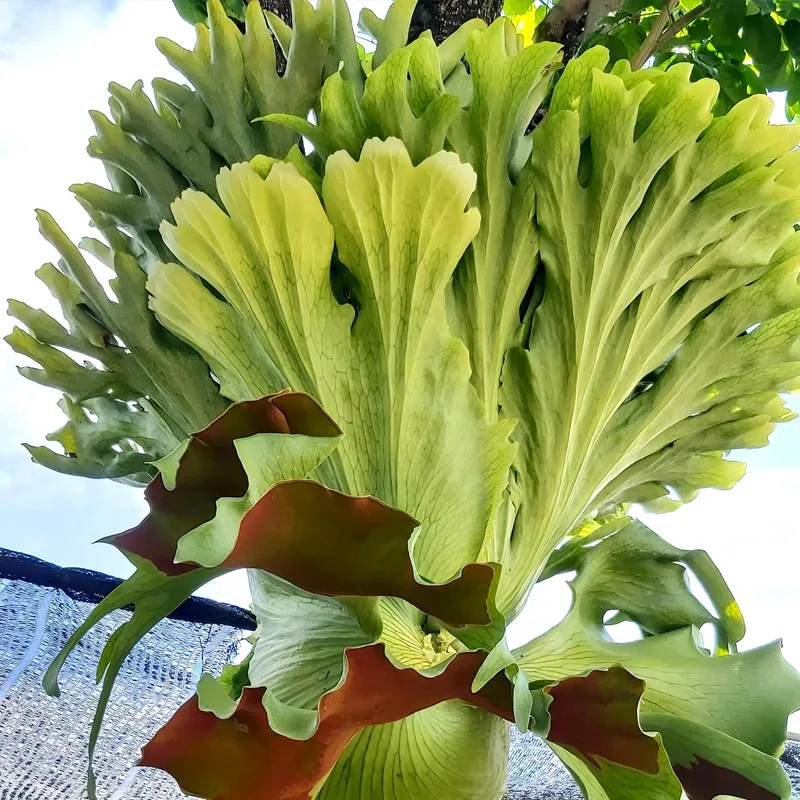
Platycerium holttumii, also known as the “He Qimei Staghorn Fern,” is a species of epiphytic fern native to the Malay Peninsula, Sumatra, and Borneo. Like other staghorn ferns, it grows attached to trees and other plants, using them for support but not as a source of nutrients. This fern is named after the botanist E.J.H. Corner, who named it in honor of his colleague, the plant collector He Qimei. It is known for its unique and attractive appearance, with two types of fronds: basal fronds that grow flat against the tree or support structure, and fertile fronds that grow upward and resemble antlers. The basal fronds are typically a greenish-grey color, while the fertile fronds are green and somewhat translucent.
6. Platycerium ridleyi (Asian monkey brain staghorn fern)
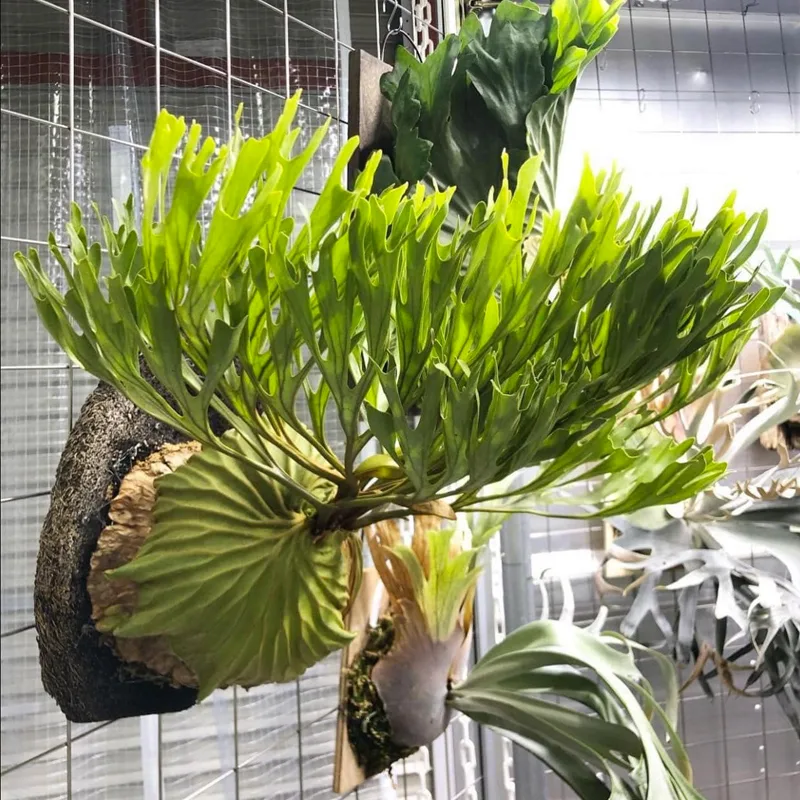
Platycerium ridleyi, also known as the “Asian Monkey Brain Staghorn Fern,” is a species of epiphytic fern native to Malaysia, Borneo, and Sumatra. Like other staghorn ferns, it grows attached to trees and other plants, using them for support but not as a source of nutrients. This fern is named after the British botanist Henry Nicholas Ridley, who collected the type specimen in 1901. It is known for its unique and attractive appearance, with two types of fronds: basal fronds that grow flat against the tree or support structure, and fertile fronds that grow upward and resemble monkey brains. The basal fronds are typically a greenish-grey color, while the fertile fronds are green and somewhat translucent.
7. Platycerium alcicorne (Buckler staghorn fern)
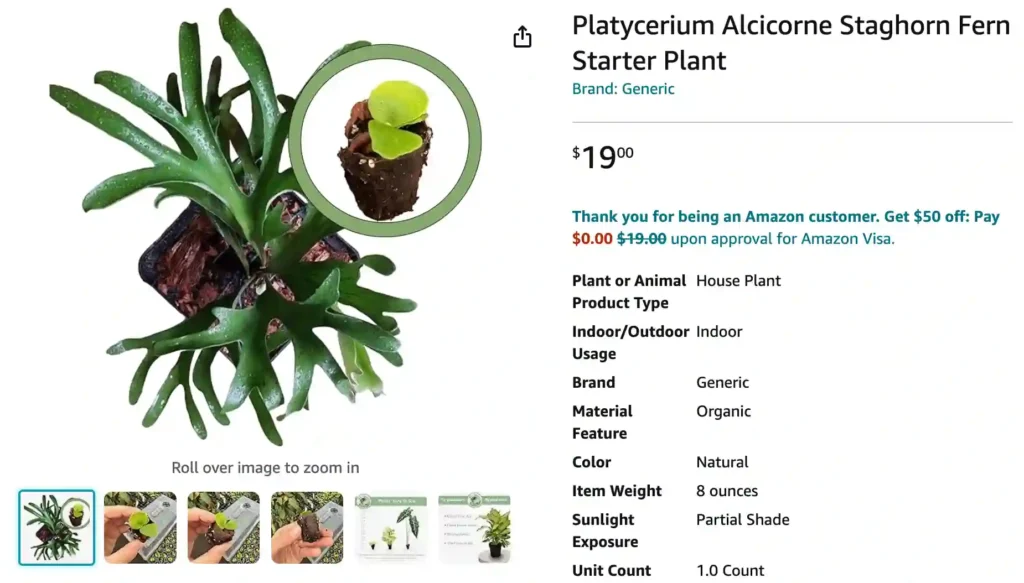
Platycerium alcicorne, commonly known as the “Buckler Staghorn Fern,” is a species of epiphytic fern native to Southeast Asia, including Thailand, Malaysia, Indonesia, and the Philippines. Like other staghorn ferns, it grows attached to trees and other plants, using them for support but not as a source of nutrients. This fern is known for its unique and attractive appearance, with two types of fronds: basal fronds that grow flat against the tree or support structure, and fertile fronds that grow upward and resemble bucklers or shields. The basal fronds are typically a greenish-grey color, while the fertile fronds are green and somewhat translucent.
8. Platycerium coronarium (Crown staghorn fern)
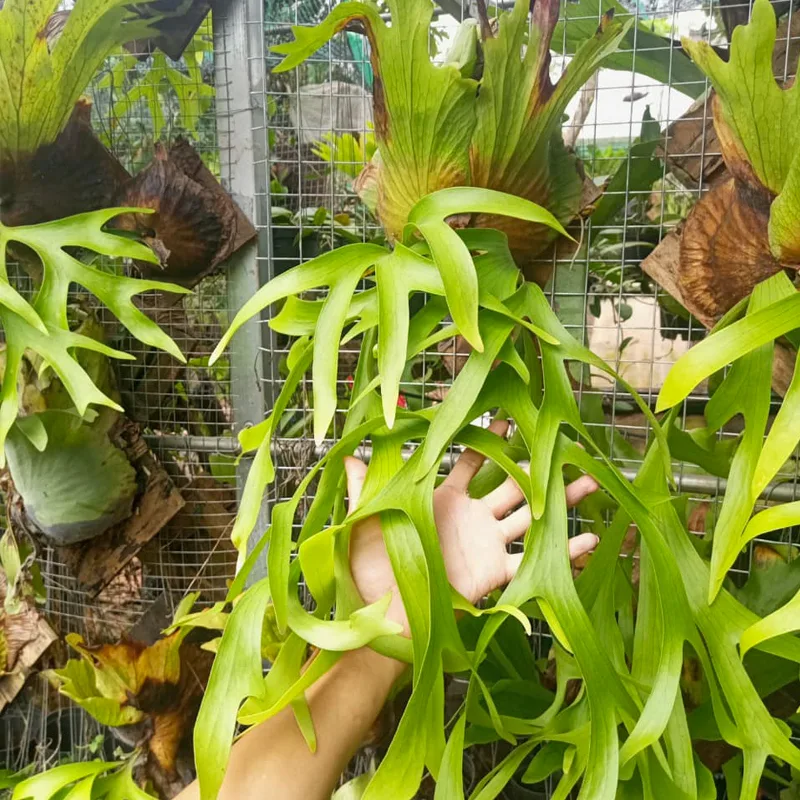
Platycerium coronarium, commonly known as the “Crown Staghorn Fern,” is a species of epiphytic fern native to Southeast Asia, including Thailand, Malaysia, Indonesia, Vietnam and the Philippines. Like other staghorn ferns, it grows attached to trees and other plants, using them for support but not as a source of nutrients. This fern is known for its unique and attractive appearance, with two types of fronds: basal fronds that grow flat against the tree or support structure, and fertile fronds that grow upward and form a distinctive crown shape. The basal fronds are typically a greenish-grey color, while the fertile fronds are green and somewhat translucent.
9. Platycerium quadridichotomum (Four-pointed staghorn fern)
Platycerium quadridichotomum, commonly known as the “Four-pointed Staghorn Fern,” is a species of epiphytic fern native to Southeast Asia, including Thailand, Malaysia, Indonesia, and the Philippines. Like other staghorn ferns, it grows attached to trees and other plants, using them for support but not as a source of nutrients. This fern is known for its unique and attractive appearance, with two types of fronds: basal fronds that grow flat against the tree or support structure, and fertile fronds that grow upward and form a distinctive four-pointed star shape. The basal fronds are typically a greenish-grey color, while the fertile fronds are green and somewhat translucent.
10. Platycerium andinum (Andes staghorn fern)
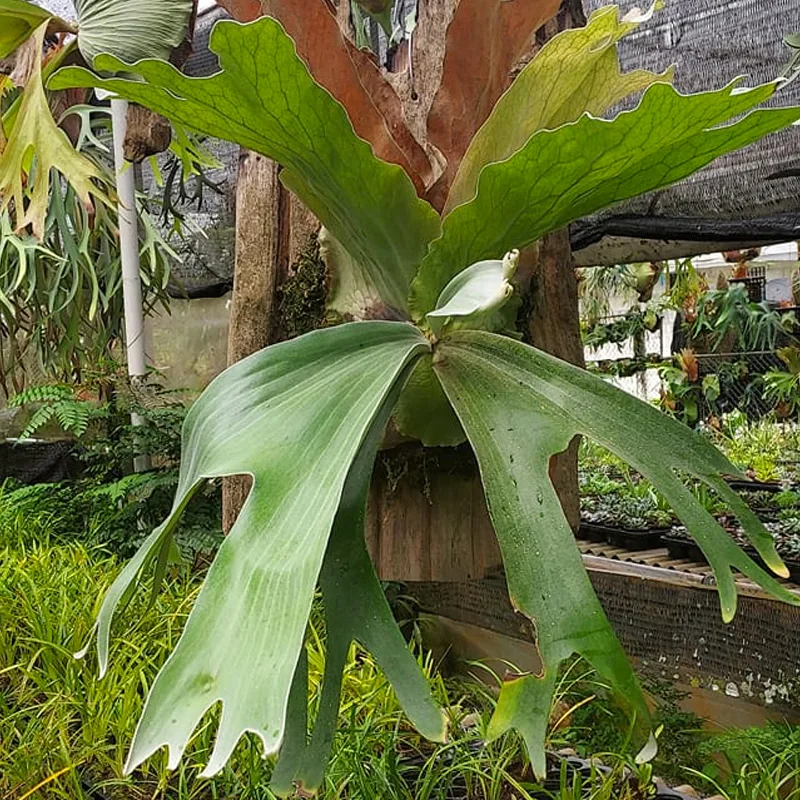
Platycerium andinum, commonly known as the “Andes Staghorn Fern,” is a species of epiphytic fern native to South America, specifically the Andes mountains of Colombia, Ecuador, and Peru. Like other staghorn ferns, it grows attached to trees and other plants, using them for support but not as a source of nutrients. This fern is known for its unique and attractive appearance, with two types of fronds: basal fronds that grow flat against the tree or support structure, and fertile fronds that grow upward and form a distinctive heart-shaped shield. The basal fronds are typically a greenish-grey color, while the fertile fronds are green and somewhat translucent.
11. Platycerium elephantotis (Elephant Ear staghorn fern)
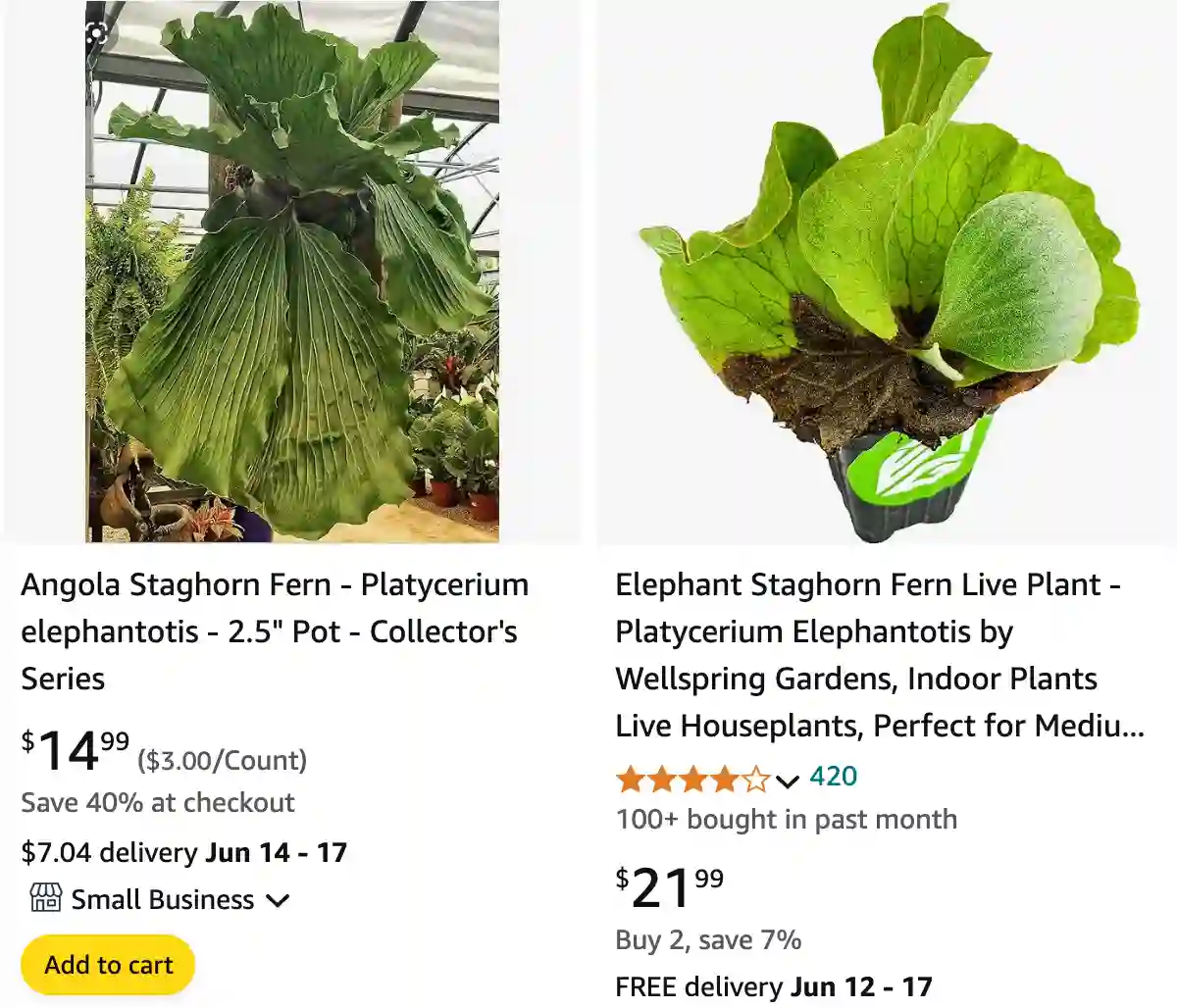
Platycerium elephantotis, commonly known as the “Elephant Ear Staghorn Fern,” is a species of epiphytic fern native to tropical regions of Africa, including Cameroon, Gabon, and Congo. Like other staghorn ferns, it grows attached to trees and other plants, using them for support but not as a source of nutrients. This fern is known for its unique and attractive appearance, with two types of fronds: basal fronds that grow flat against the tree or support structure, and fertile fronds that grow upward and form a distinctive elephant ear shape. The basal fronds are typically a greenish-grey color, while the fertile fronds are green and somewhat translucent.
12. Platycerium madagascariense (African monkey brain staghorn fern)
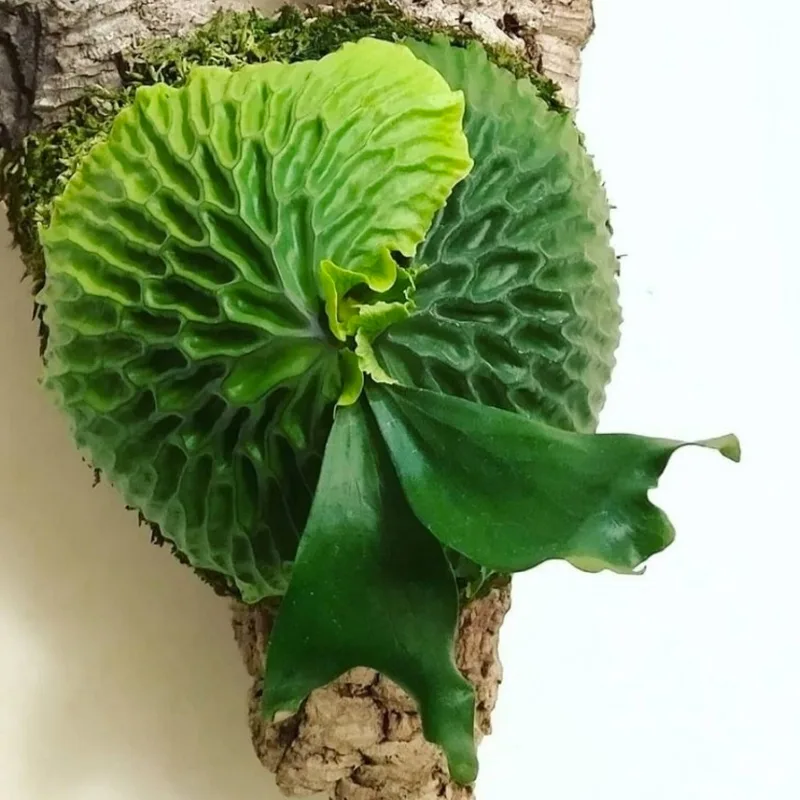
It is native to Madagascar and is known for its large size and unique frond shape. The basal fronds of Platycerium madagascariense are narrow and strap-like, while the fertile fronds are broad and fan-shaped, resembling the shape of a hand with fingers spread apart. The fertile fronds can grow up to 60cm in length and are covered with a dense layer of brownish scales.
13. Platycerium bifurcatum (Digital staghorn fern)
Platycerium bifurcatum, commonly known as the “Elkhorn fern” or “Staghorn fern,” is a species of epiphytic fern native to tropical regions of Southeast Asia and the Pacific islands. It is known for its distinctive frond shape, which resembles the antlers of a deer or elk. The fronds of Platycerium bifurcatum are divided into two types: sterile, basal fronds that form a flat, shield-like structure against the tree or other support, and fertile, antler-like fronds that extend upwards and can reach up to 90cm in length. The fertile fronds are forked, or bifurcated, near the base, giving rise to the common name “Digital staghorn fern.” The plant does not have true roots, but instead anchors itself to its support structure with a mass of tangled, wiry rhizomes.
14. Platycerium stemaria (Triangle staghorn fern)
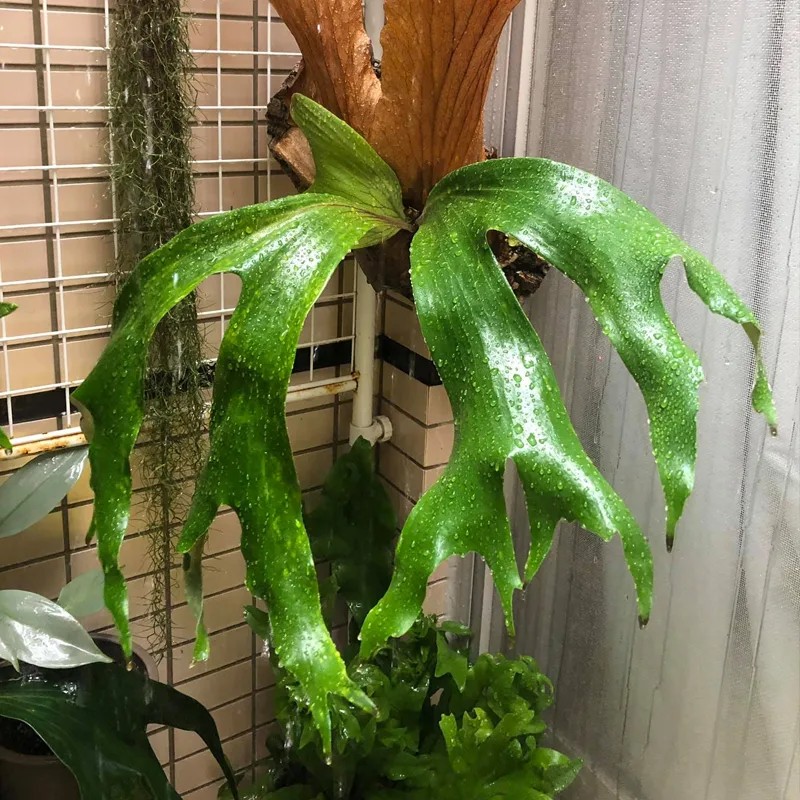
Platycerium stemaria, commonly known as the “Triangle Staghorn Fern,” is a species of epiphytic fern native to tropical regions of Africa, including Cameroon, Gabon, and Congo. Easy to produce lateral buds. The long forks at the end of the sporophyte look bit like a polygon, with high nutrition and wavy shape.
15. Platycerium veitchii
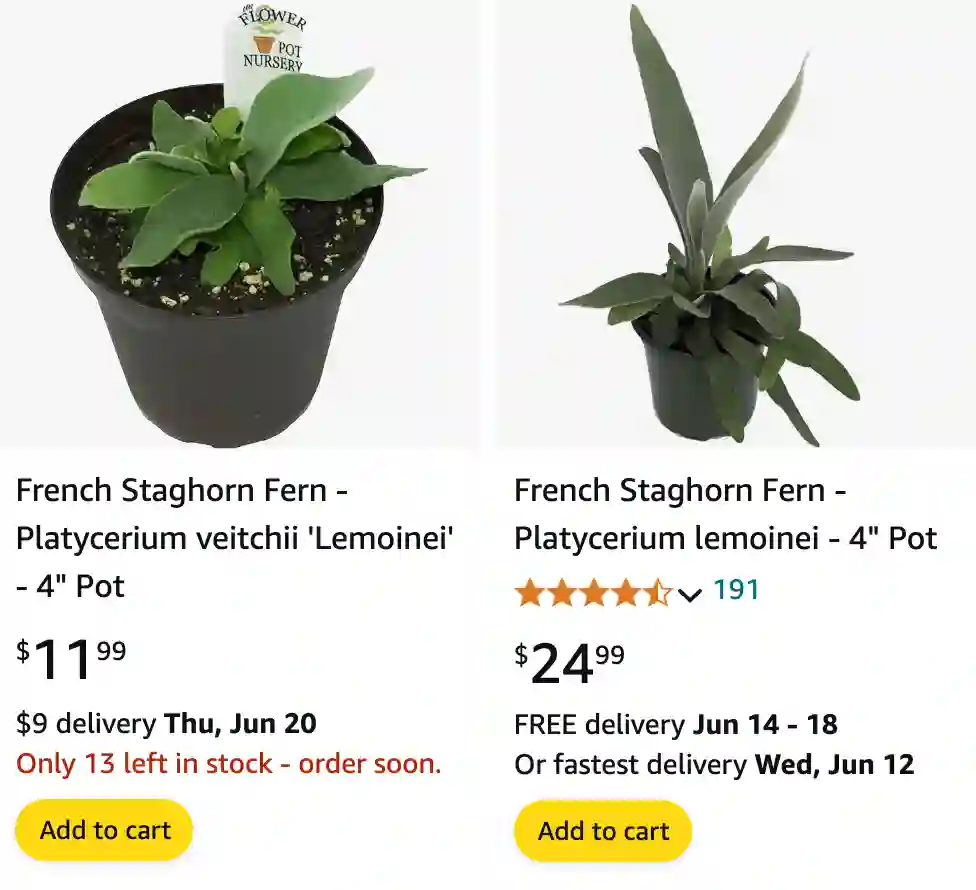
Platycerium veitchii, also known as the Veitch’s staghorn fern, is a species of fern in the family Polypodiaceae. It is native to the rainforests of southeastern Asia, including Malaysia, Indonesia, and the Philippines. This fern is known for its unique appearance, with large, flat, antler-like fronds that can reach up to 1 meter in length. The fronds are covered in small, brownish scales, which help the plant absorb moisture and nutrients from the air.
16. Platycerium willinckii (Java staghorn fern)
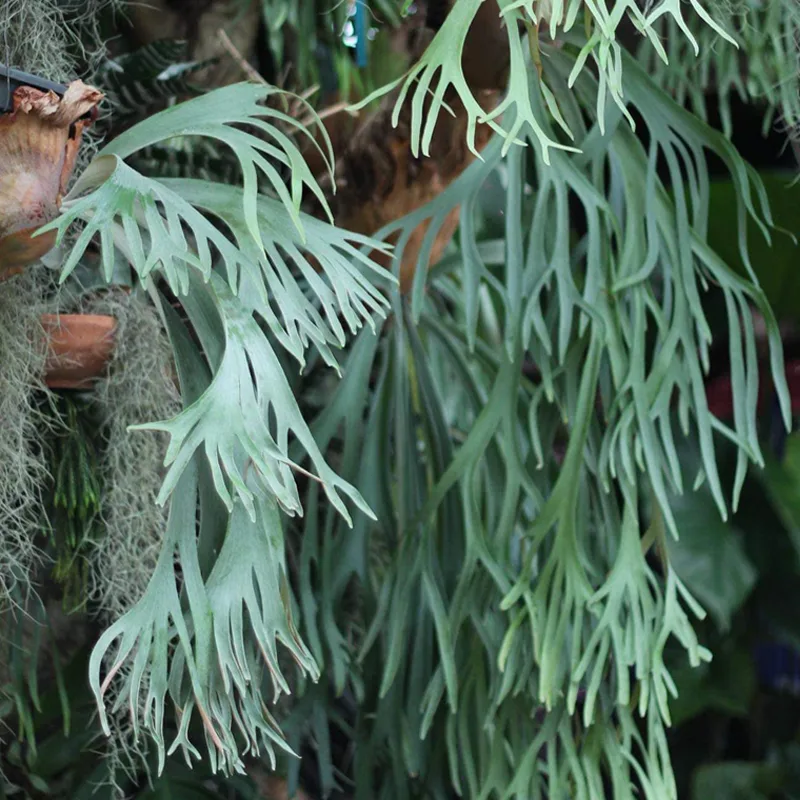
Platycerium willinckii, also known as the Java staghorn fern, is a species of fern in the family Polypodiaceae. It is native to Java, Indonesia, and is known for its unique, antler-like fronds that can grow up to 1 meter in length. This fern is epiphytic, meaning that it grows on other plants or objects rather than in soil. It attaches itself to trees or rocks with its basal fronds, while the fertile fronds (the ones that produce spores) grow upwards and outwards. The fertile fronds are divided into two distinct sections – the sterile shield frond, which covers the basal fronds, and the fertile frond, which grows above the shield frond and produces spores.
17. Platycerium hillii (Dark Green staghorn fern)
Platycerium hillii, also known as the Dark Green staghorn fern, is a species of fern in the family Polypodiaceae. It is native to the rainforests of eastern Australia, including Queensland and New South Wales. This fern is epiphytic, meaning that it grows on other plants or objects rather than in soil. It has two distinct types of fronds – the basal fronds, which are sterile and flat, and the fertile fronds, which are upright and antler-like. The fertile fronds are dark green in color and can grow up to 1 meter in length.
18. Platycerium ellisii (Alice staghorn fern)
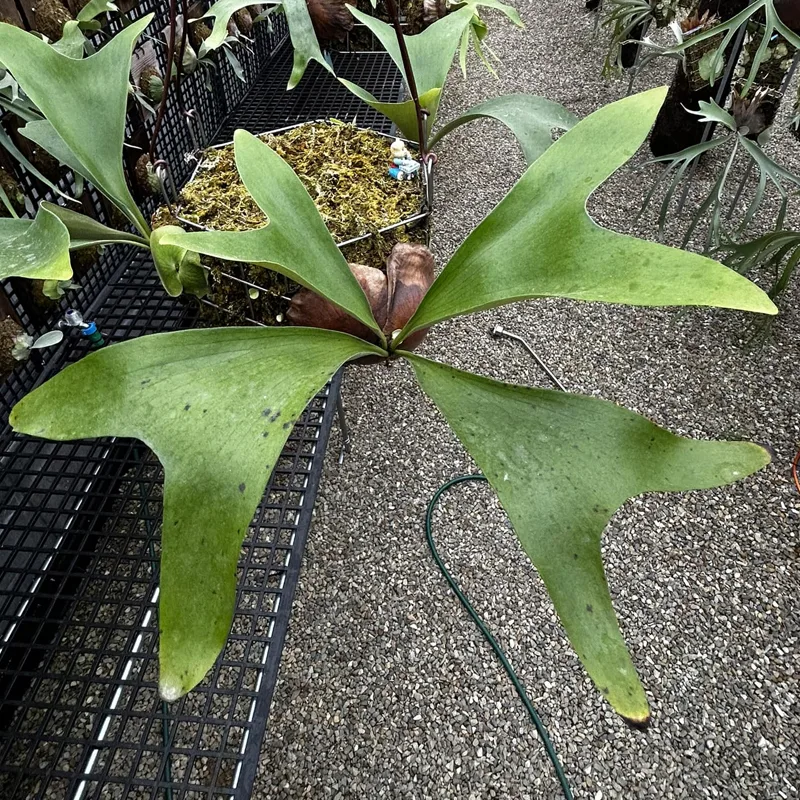
Platycerium ellisii, also known as the Alice staghorn fern, is a species of fern in the family Polypodiaceae. It is native to the rainforests of Papua New Guinea. This fern is epiphytic, meaning that it grows on other plants or objects rather than in soil. It has two distinct types of fronds – the basal fronds, which are sterile and flat, and the fertile fronds, which are upright and antler-like. The fertile fronds are light green in color and can grow up to 1 meter in length.
12 Hybrid Species
19. Platycerium Joe Young – granddia (Giant monkey staghorn fern)
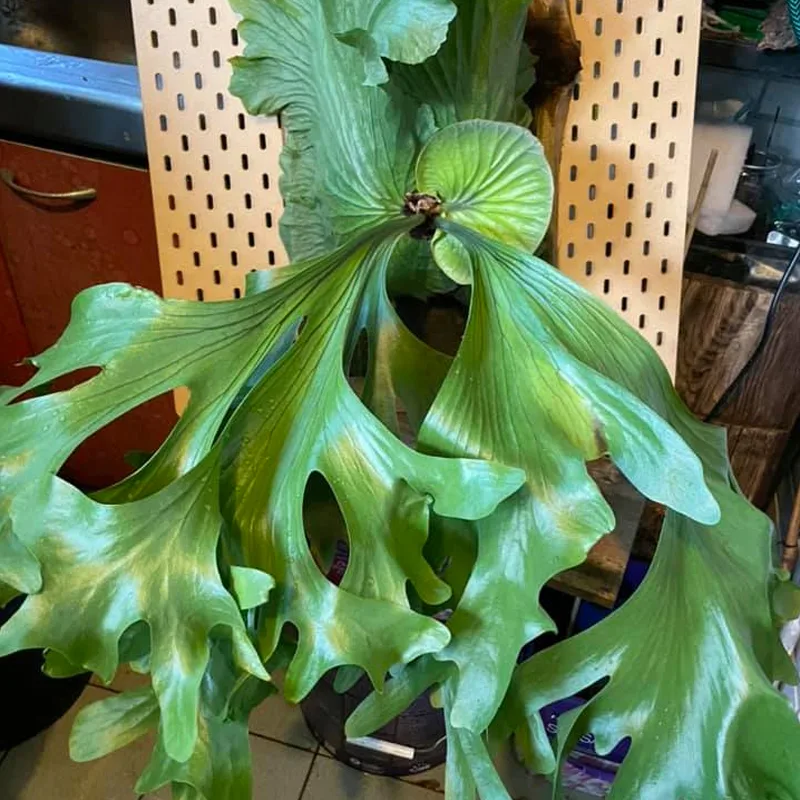
HYBRID: P.Ridleyi x P.Grande (Monopodial Type)
20. Platycerium kitshakoodiense (Asian Emperor Staghorn Fern)
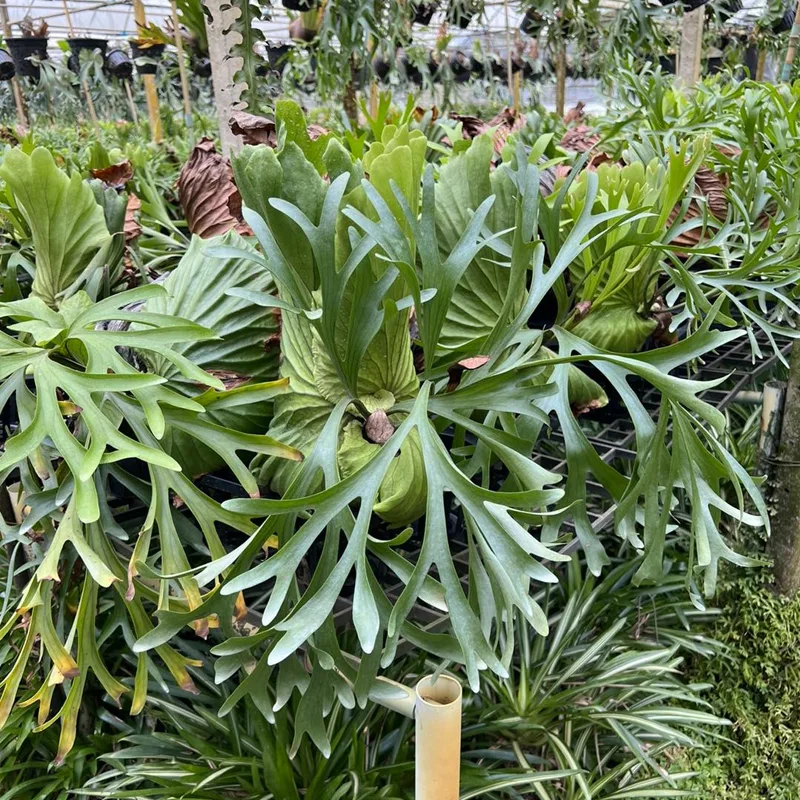
PHYBRID: P.Ridleyi x P.Coronarium (Monopodial Type)
21. Platycerium Charles Alford (Afu staghorn fern)
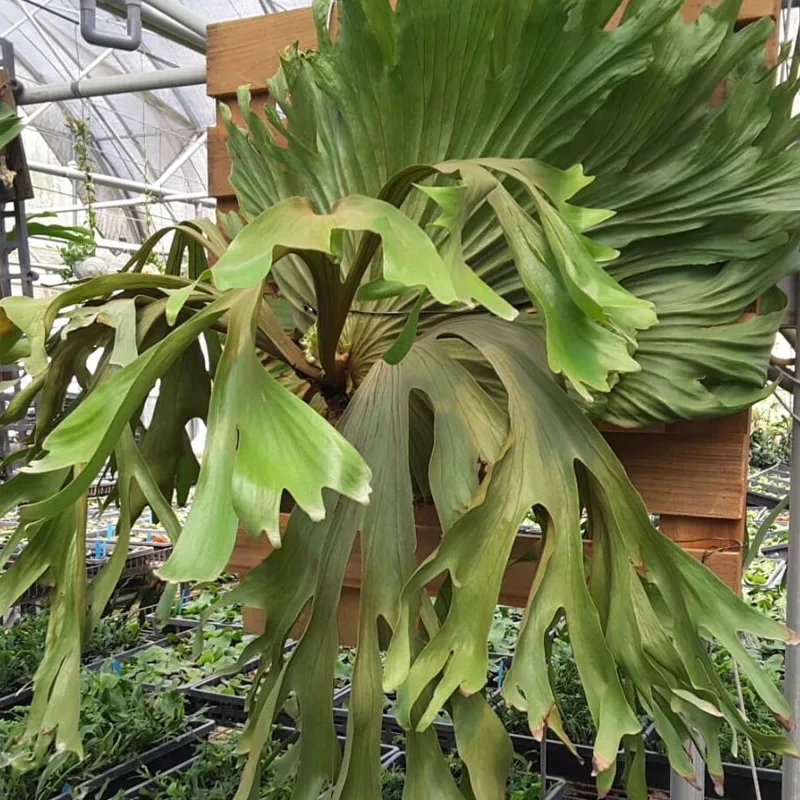
HYBRID: P.Ridleyi x P.Wandae (Monopodial Type)
22. Platycerium Horne’s Surprise (Non-non-staghorn fern)
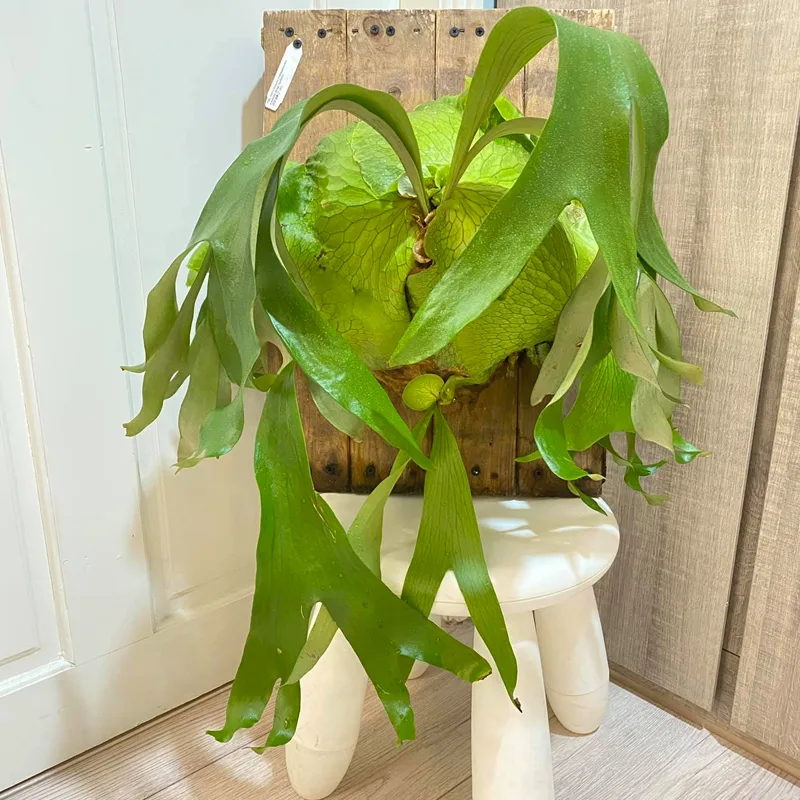
HYBRID: P.Madagascariense x P.Alcicorne (Pup-forming Type)
23. Platycerium Budsaba (Non-Q staghorn fern)
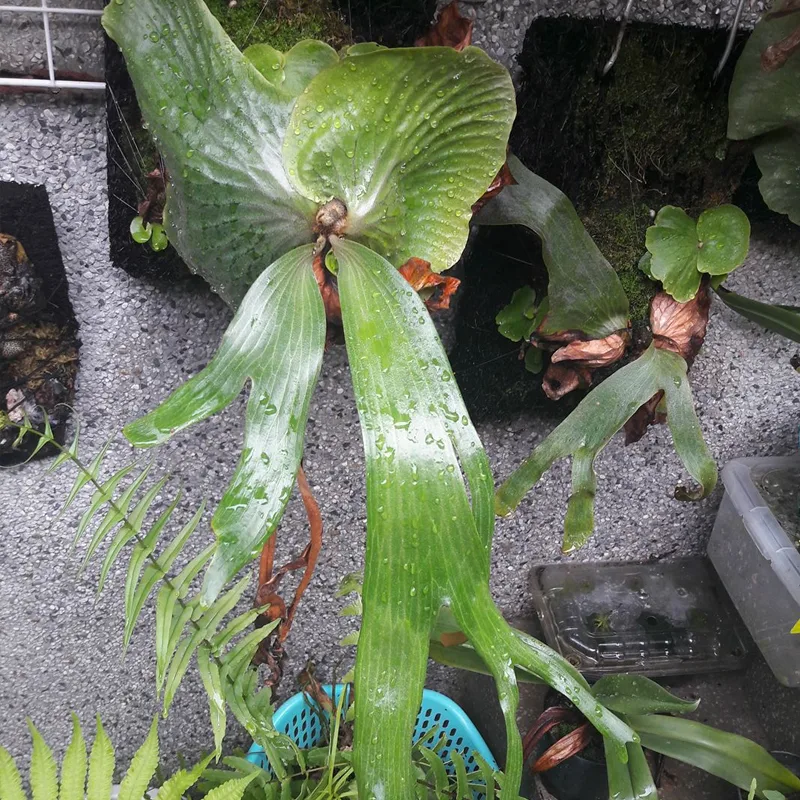
HYBRID: P.Madagascariense x P.Quadridichotomum (Pup-forming Type)
24. Platycerium Neptune (Triangle elephant staghorn fern)
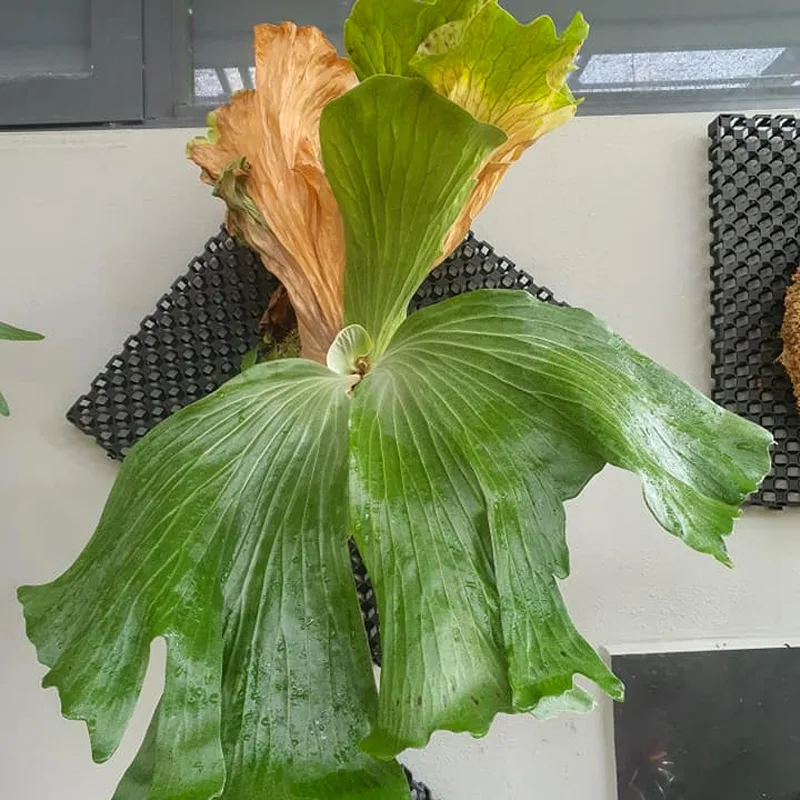
HYBRID: P.Elephantotis x P.Stemaria (Pup-forming Type)
25. Platycerium Siamense Silver Velent (Elephant claw staghorn fern)
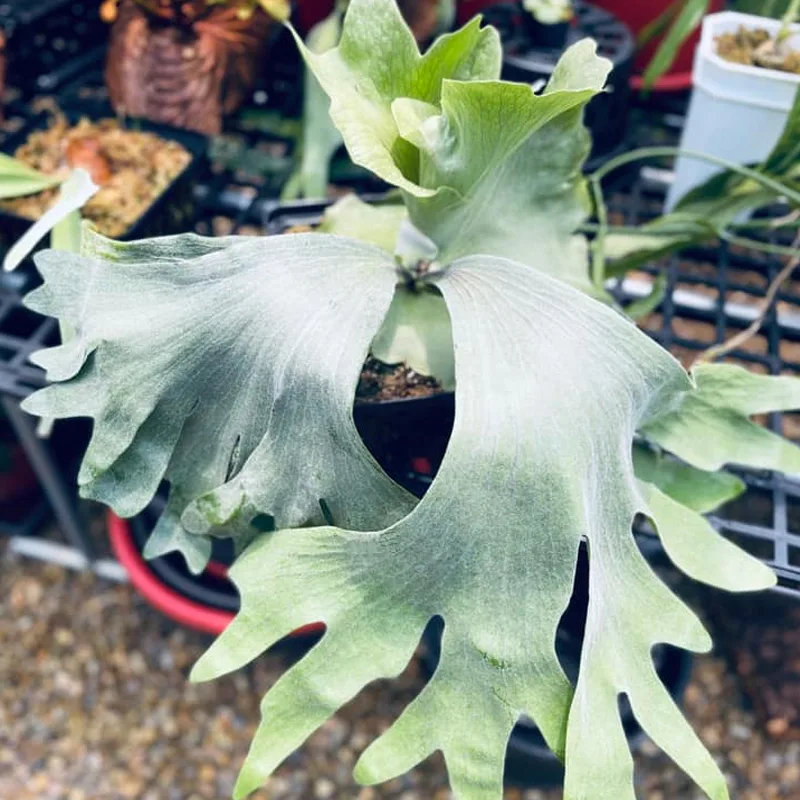
HYBRID: P.Elephantotis x P.Willinckii (Pup-forming Type)
26. Platycerium Antis (Anxiang staghorn fern)
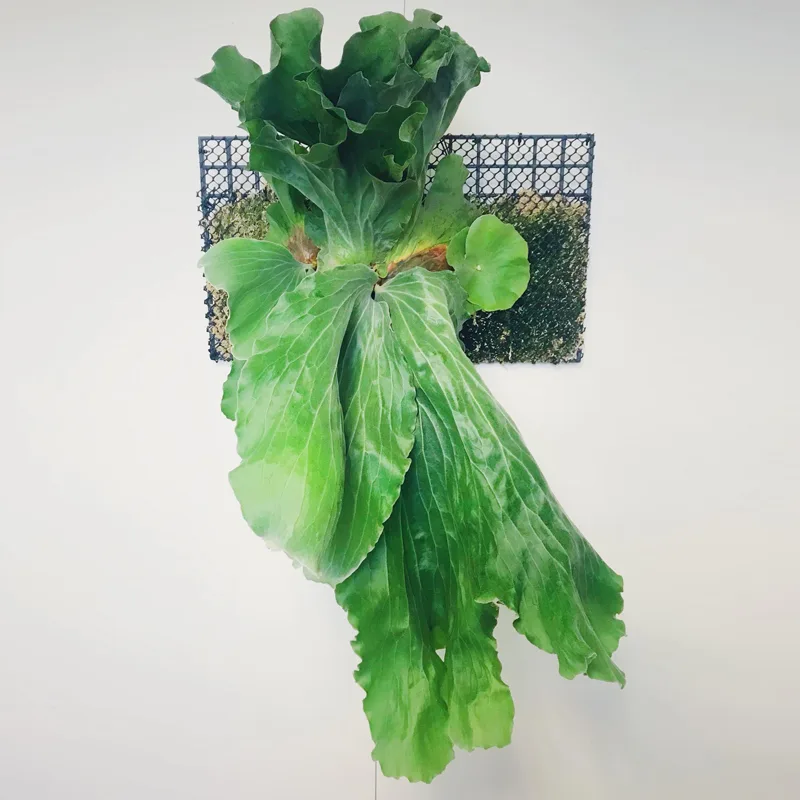
HYBRID: P.Elephantotis x P.Andinum (Pup-forming Type)
27. Platycerium Diversifolium
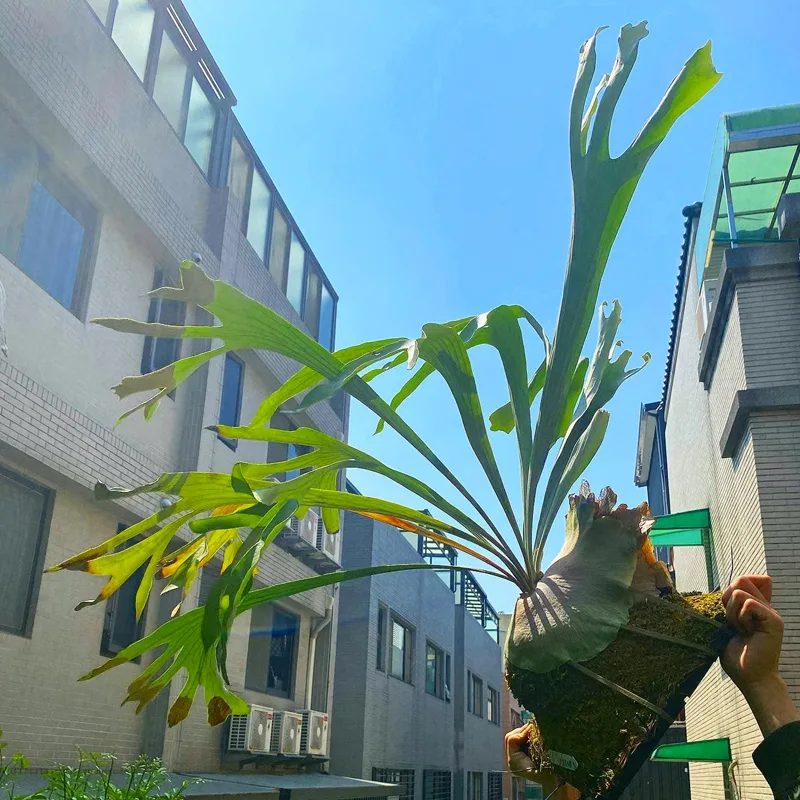
HYBRID: P.Bifurcatum x P.Hillii (Pup-forming Type)
28. Platycerium White Hawk (White Hawker Staghorn Fern)
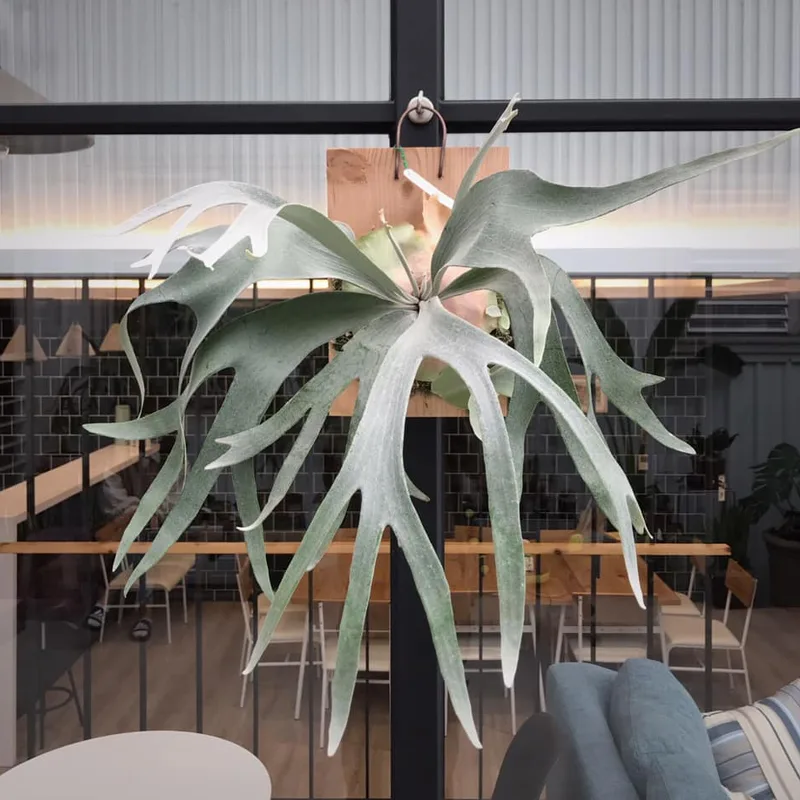
HYBRID: P.Diversifolium x P.Willinckii (Pup-forming Type)
29. Platycerium Pewchan (Pichen staghorn fern)
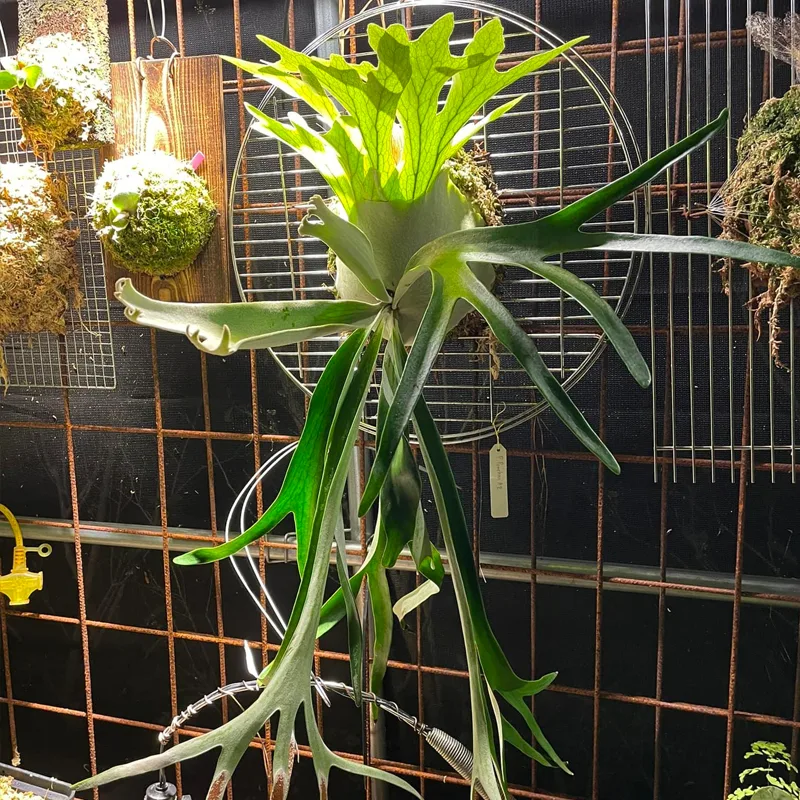
HYBRID: P.Veitchii x P.Willinckii (Pup-forming Type)
30. Platycerium Saikeaw (Anclaw staghorn fern)
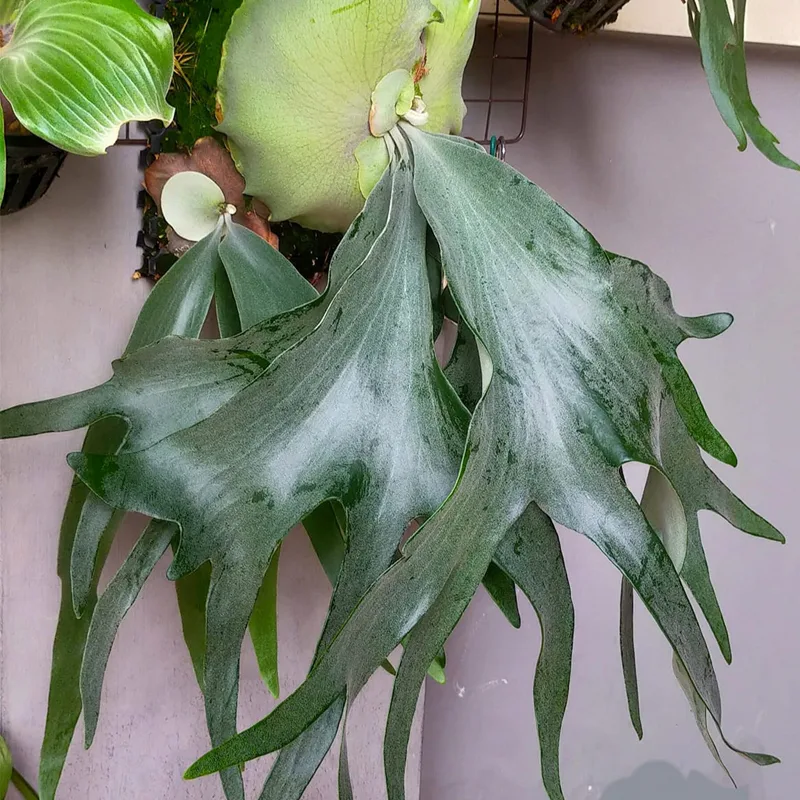
HYBRID: P.Andinum x P.Willinckii (Pup-forming Type)
How to Care for Staghorn Fern?
Caring for a Staghorn Fern might seem daunting at first, but it’s fairly straightforward once you get the hang of it. These ferns thrive in indirect light, so I place mine in a bright spot away from direct sunlight. They prefer high humidity, so misting them regularly or placing a humidifier nearby helps. The key is to keep the soil consistently moist but not soggy. I use a well-draining potting mix to prevent root rot. Ensuring good air circulation around the plant also keeps it healthy.
How to Save a Dying Staghorn Fern?
If your Staghorn Fern is looking sad, the first thing to check is its environment. A common issue is overwatering, which can lead to root rot. Make sure the plant is in a pot with adequate drainage and allow the top layer of soil to dry out before watering again. If the fern is wilting, it could also be a sign of underwatering. Adjust your watering routine based on the plant’s needs. Additionally, check for pests like scale or mealybugs, which might be affecting your fern.
How to Water Staghorn Fern?
Watering Staghorn Ferns is a bit of an art. I water mine when the top inch of soil feels dry to the touch. During the winter months, I reduce watering frequency since the plant’s growth slows down. I use room-temperature water and ensure it drains well to avoid waterlogging. A good practice is to water thoroughly until excess water starts to drain from the bottom of the pot.
How Do You Hang a Staghorn Fern?
Hanging a Staghorn Fern is one of the most striking ways to display it. I’ve found that mounting it on a wooden board or a piece of cork works well. Start by attaching the fern to the mount using wire or a strong adhesive. Make sure to secure it so the roots are well-supported but not tightly bound. Hang the mounted fern in a location with bright, indirect light. This setup mimics their natural epiphytic habitat and allows the fern to thrive.
How to Fertilize Staghorn Fern?
Fertilizing Staghorn Ferns is essential for their growth. I use a balanced, water-soluble fertilizer diluted to half strength. Fertilize every 6-8 weeks during the growing season (spring and summer) and reduce or stop during the winter months. Avoid over-fertilizing, as this can lead to salt buildup and damage the plant. A gentle feeding routine helps keep the fern healthy and vibrant.
Is Staghorn Fern Toxic to Cats?
One of the reasons I appreciate Staghorn Ferns is that they are non-toxic to cats. If you have feline friends, you don’t have to worry about them chewing on the plant. This makes Staghorn Ferns a great choice for pet-friendly homes.
Staghorn Fern vs Bird’s Nest Fern
When comparing Staghorn Ferns to Bird’s Nest Ferns, the key difference lies in their appearance and growth habits. Staghorn Ferns have their distinctive antler-like fronds, while Bird’s Nest Ferns have broad, wavy leaves that form a rosette. Both ferns enjoy similar care conditions, such as indirect light and high humidity, but Bird’s Nest Ferns are usually grown in pots, whereas Staghorn Ferns are often mounted.
Staghorn Fern vs Elkhorn Fern
Staghorn Ferns and Elkhorn Ferns are often confused due to their similar appearances. However, Elkhorn Ferns have narrower, more elongated fronds compared to the broader, more rounded fronds of Staghorn Ferns. Both types of ferns are epiphytic and enjoy similar care, but Elkhorn Ferns can be a bit more tolerant of lower humidity levels.
How to Propagate Staghorn Fern?
Propagation of Staghorn Ferns can be done through offsets or spores. I prefer separating the offsets, which are small plants that grow around the base of the parent fern. Gently remove these offsets, ensuring they have some roots attached, and mount them on a new board or in a pot with the same care as the parent plant.
What to Plant With Staghorn Fern?
Staghorn Ferns pair well with other tropical plants that enjoy similar growing conditions. I like to combine them with orchids, bromeliads, or even air plants. These companions create a lush, layered look and thrive in the same high humidity and indirect light conditions.
Benefits and Common Problems
Staghorn Ferns not only add visual interest but also help improve indoor air quality by filtering toxins. Common problems include root rot from overwatering and pests like scale insects. Regular misting, proper watering, and good air circulation help prevent these issues.
Overall, staghorn ferns are unique and interesting plants that can add a touch of tropical flair to any collection.
If i die, water my plants!
